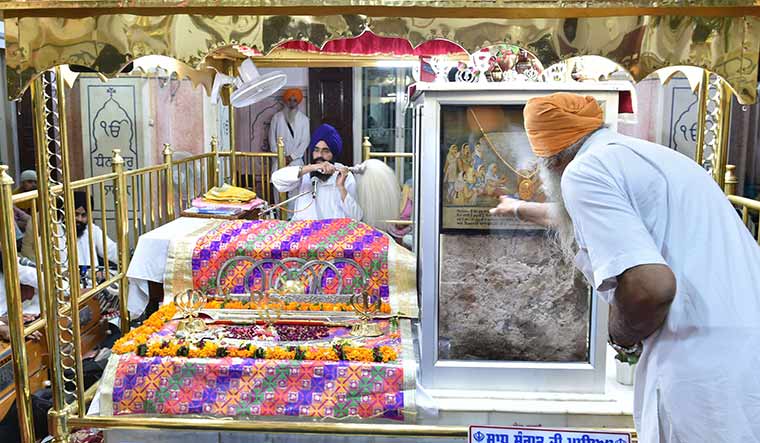In a tiny lane in the old city of Batala, in the Gurdaspur district of Punjab, the story of Guru Nanak’s wedding is preserved as if it happened yesterday. Strings of pearls, part of the famous sehras of the region, shine like mini moons in every shop. The sehra, traditionally tied over the groom’s turban, is as vital to a wedding as a veil is for the bride. For visitors, especially those who had promised to come to Batala if their wish of companionship was granted, the sehra is at the top of their shopping list.
For, a sehra from the place where Guru Nanak got married does come with a little magic.
The legend goes thus: Guru Nanak and his baraat (wedding party) were waiting to be greeted by the in-laws. He chose to rest near a mud wall. A well-meaning elderly lady warned him it was dangerous. Nanak is believed to have smiled and told her not to worry, the wall would stand for centuries. A section of the wall still stands, squashed between glass to prevent people from touching it. It is a witness to the wedding and is seen as proof of the Guru’s miracles. And this is where the Kandh Sahib gurdwara was later built.
A few steps from this gurdwara is Gurdwara Dera Sahib, where the wedding took place. A painting depicting the wedding hangs in this tiny space and a Guru Granth Sahib is displayed in a glass enclosure. Apart from the board, there is little memory left.
Such relics, associated with the Sikh gurus, are scattered across India. For instance, there is the chola (cloak) of Guru Nanak in Chola Sahib near Dera Baba Nanak, the last gurdwara at the very edge of India before the land becomes Pakistan. Patna has Guru Tegh Bahadur’s sandals, edged with gold, and a turban that belonged to Guru Hargobind is lovingly kept by a family in Punjab.
Even Sultanpur Lodhi—a town in Punjab at the centre of Guru Nanak’s 550th birth anniversary celebrations—has only transformed in the past few years. It is a town where Nanak moved to with his sister Nanaki, had children, found work, acquired a following for his message of oneness and started his journey with his friend Mardana.
Artist Arpana Caur remembers a time when the city was not even on the map of most devotees. The gurdwara that now marks the place where his sons were born was just a simple building. “There was not even a langar hall,” she says. Caur spent the money she earned from her Nanak series—a few paintings are currently on display in San Francisco and Phoenix—to buy the basic utensils so that the gurdwara could start a langar seva. Now, the gurdwara is enshrined in white marble. “Thanks to an NRI,” she says.
The youngest major religion of India has an advantage over the others—age. In the seven decades post partition, there has been a focus on preserving the religion, but it has been driven by devotion and not by authenticity and history. If the many gurdwaras in Pakistan met the fate of neglect, in India, the gurus have found themselves clad in marble and their legends have been kept alive lovingly.
Amardeep Singh, an avid photographer, traveller and now historian, left his corporate job in 2014 to travel and document the legacy of his forefathers in Pakistan and to look for lesser-known gurdwaras. “Our history books tell us they built more,” he says.
The result? Two books that painstakingly document the physical remnants of the past. In The Lost Heritage—The Sikh Legacy in Pakistan and The Quest Continues: Lost Heritage—The Sikh Legacy in Pakistan, Singh maps each significant spot to give readers an idea of how much was actually lost.
“We lost access to our land,” says Amardeep, who lives in Singapore. “But seven decades after partition, have we come out any better? I think we are worse off. What have we done? Someone asked me in a talk, ‘You have done such great work in Pakistan. What are you going to do in India?’ I said never. Because in India, these marble- and gold-ridden structures do not tell me what my forefathers were trying to tell me. You have plastered over [them] and there is gold and marble.”
In The Quest Continues, Amardeep has pictures of frescoes that show an inclusive faith, where Radha Krishna and even Shravan Kumar find space on the walls of gurdwaras. “Can you imagine Shravan Kumar in a gurdwara now?” he asks. For him, the loss of the tangible is tied deeply with the loss of a culture and ethos.
Another Sikh writer, Rishi Singh, also looks at the importance of the Sikh story through a lens where the sacred is just one parameter. Rishi, who has a doctorate from the School of Oriental and African Studies, University of London, and now lives in Canada, took off on a journey across India to write Sikh Heritage—A History of Valour and Devotion. The book puts culture, which often gets ignored in the Sikh story, at the centre. “The focus of most research has been on the bani (the sacred text). The archaeological and monumental aspects are not there,” he says.
The stories do exist, lovingly preserved and passed on as heirlooms, but it is time to root the legacy in history, too. The Sikhs deserve that.


